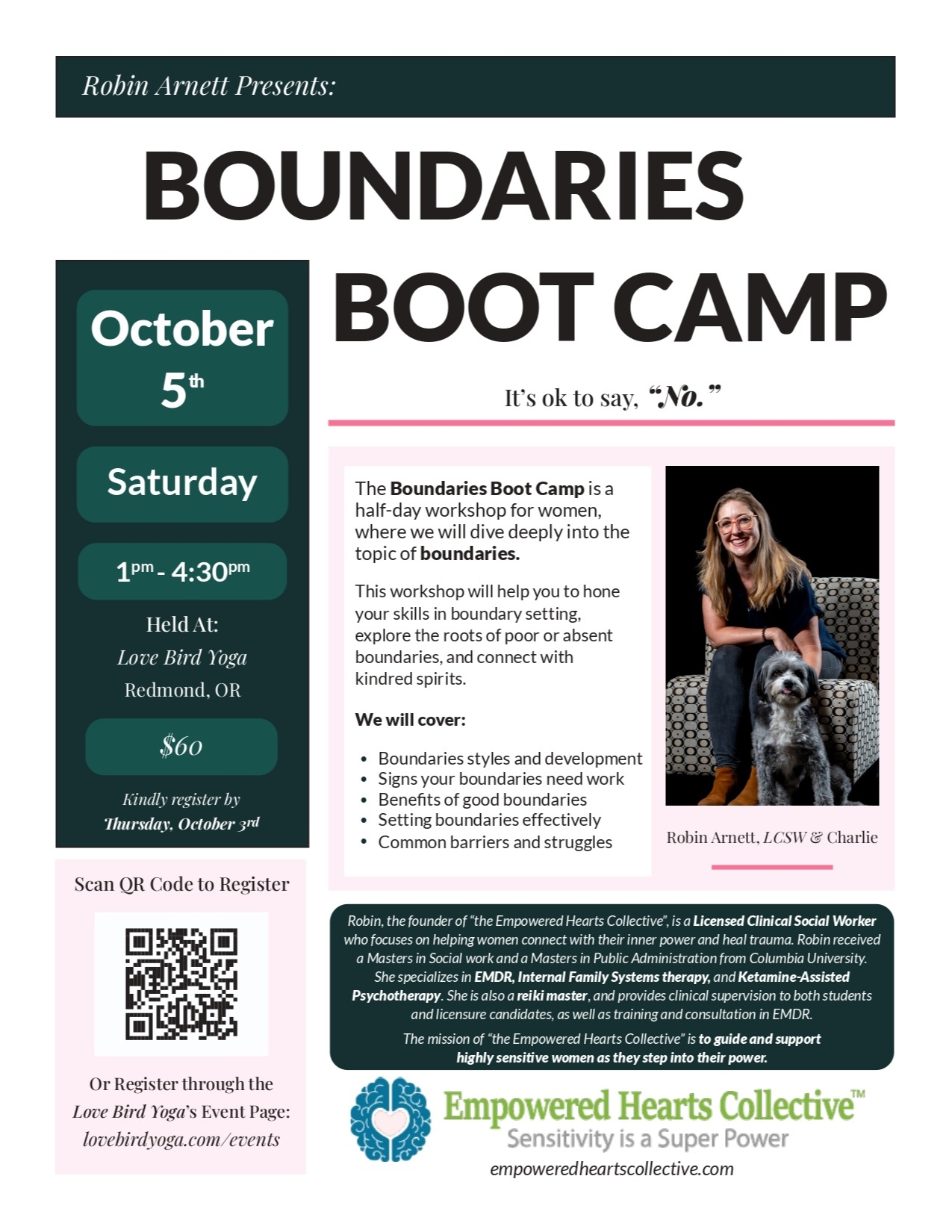Take the first step to stronger boundaries—unlock your free course, Module 7: Setting Effective Boundaries, from the Intuitive Boundaries Mastery Series.
Unlock Free ModuleEMDR 101
EMDR Basics for New Clients
By Robin Arnett
EMDR is an evidence-based therapy approach that can lead to profound and lasting changes. I wrote this post to help explain some of the basics. We'll talk about:
- How EMDR was developed
- The philosophy behind EMDR
- How EMDR works
- What it's like to be an EMDR client
EMDR has been the core of my practice for many years. I believe in it so strongly that I’ve sought out additional training to become an Approved Consultant in EMDR and a training facilitator with the EMDR Humanitarian Assistance Program.
EMDR is truly life changing. I hope this post can give you some encouragement to seek out EMDR as a part of your healing journey.
What is EMDR?
EMDR is an acronym that stands for Eye-Movement Desensitization and Reprocessing. The “eye-movement” part of the name is actually a bit of a misnomer. EMDR was first facilitated (and still is) by clinicians having their clients watch their fingers move back and forth across a visual plane. This eye-movement has the effect of creating bilateral stimulation (BLS) between the two sides of the brain. In addition to eye-movement, BLS can also be activated by sound, or with tactile stimulation like tapping.
BLS is the key to the “magic” of EMDR. Through BLS, EMDR is able to help remap the neural pathways that inform our belief systems and ways of being. We reroute from negative patterns to more adaptive ways of thinking that feel real and true to us.
There is a ton of clinical research that supports the use of EMDR for single-incident traumas like assaults, car accidents, or the death of a loved one. However, it is also effective in treating the complex trauma that results from Adverse Childhood Experiences, including neglect, physical abuse, and witnessing substance abuse in the home. EMDR can be used to address mental health conditions like PTSD, anxiety, depression, insecure attachment, and more. It is a comprehensive approach.
How was EMDR Developed?
EMDR was developed by Dr. Francine Shapiro throughout the late 1980s and 1990s. Dr. Shapiro essentially stumbled onto EMDR while taking a walk in the park (no pun intended) and thinking about an issue that was distressing to her. She noticed that she felt better about this issue as her eyes scanned back and forth across her environment. Brilliantly, she thought maybe there was something to that, and followed the thread.
Dr. Shapiro went on to experiment with eye movements using herself and her colleagues as subjects, and later expanded into more formal clinical research. She found that thinking about a distressing event while tuning into eye movements had the effect of causing traumatic memories to be less disturbing. As research progressed, Shapiro also discovered that continuing with eye movements helped participants to reprocess their memories in a way that was adaptive and empowering.
The Adaptive Information Processing (AIP) Model
EMDR is rooted in a theoretical framework called the Adaptive Information Processing model, or AIP. AIP forms the basis of everything we do with EMDR.
AIP draws from the idea of "memory networks." A memory network is a group of memories that are formed around a particular belief or idea. Memory networks form the basis of both psychological health and psychological dysfunction. Our memory networks come to be extremely important in the way we think about ourselves and our lives, and form the schemas through which we see our experiences.
Every one of us possesses “adaptive” memory networks, and “maladaptive” memory networks. Adaptive memory networks are oriented around beliefs and cognitions that are helpful to us, such as, “I am loved,” “I am safe,” or, “I have options.” Malaptative memory networks, on the other hand, are connected to beliefs that do not serve us, such as “I’m worthless,” “I'm bad,” or “I'm not safe.” When we have new experiences, they are added to our established memory networks. One of the goals of EMDR is to “reprocess” traumatic memories into adaptive memory networks, and to grow and strengthen those positive beliefs.
AIP suggests that our psychological systems, like our bodies, are naturally geared toward health, like a cut healing on its own. If we break a bone, a doctor will put a cast around the injury to help it heal, but it isn’t the cast that does the healing. Our bodies have an intuitive healing process that takes place naturally if it’s allowed to flow. The same is true for our nervous systems and our mental and emotional health. What happens with trauma is that this natural process gets stuck. EMDR helps to unstick those gears to allow healing to take its course.
What Makes EMDR Effective?
There are a few dominant theories on EMDR and why it works. We do know that studies show that eye movements have an effect on memory retrieval, vividness of those memories, and emotional arousal. These theories are working memory, dual-attention, and relationship to REM sleep.
The brain has limited capacity, and bilateral stimulation takes up attention. The idea behind the working memory theory is that engaging BLS while recalling a trauamtic memory overtaxes the brain, making the memory more fuzzy, and reducing disturbance.
Dual-Attention
“Dual-attention” means being able to revisit the past while keeping one foot in the present moment. BLS helps folks to return to past traumas without getting flooded by keeping their attention on a present stimulus. Being able to return to those memories without getting overwhelmed opens the door to reprocessing and healing.
REM Sleep
Studies indicate that the repetitive redirecting of attention that happens during EMDR has the effect of inducing a neurobiological state similar to REM sleep. While we’re in REM sleep, our brains are sorting through the experiences that we’ve had throughout our day, and deciding where to put them. Simulating that process gives the brain an opportunity to rearrange stuck and/or traumatic memories into adaptive memory networks. As we believe with AIP, the brain naturally orients toward health when given the chance.
What’s it like to do EMDR as a Client?
If you’re at all familiar with EMDR, you probably think of it as just the part where the eye-movement happens. In fact, this is just one phase of the process, Phase 4: Reprocessing and Desensitization. Really “doing” EMDR is any therapeutic work that is based in the AIP model.
EMDR actually has eight phases in total. These are:
- Phase 1: History taking
- Phase 2: Preparation
- Phase 3: Assessment
- Phase 4: Reprocessing & Desensitization
- Phase 5: Installation
- Phase 6: Body Scan
- Phase 7: Closure
- Phase 8: Reevaluation
How soon you get into Phase 4 will depend on the client, and the goals for therapy. For some clients, it could be appropriate to jump in within the second session, and for others, Phases 1 and 2 could take years. All of this is still EMDR, just at a different pace.
Phase 3 begins with identifying a target memory. This memory could be obvious, but it might also take some digging to find a core memory to represent a theme. Working from that image, you’ll identify the “negative cognition” that characterizes that memory for you, as well as the “positive cognition” that you’d like to grow. You’ll also name emotions and body sensations that come up when you tune in to all of that.
Phase 4 starts by getting the bilateral stimulation going as eye movements, tones, or tactile stimulation. Then the brain gets to work. The client’s and therapist’s jobs are essentially to get out of the brain’s way and let it do its thing.
The brain will take you through the memory network that’s associated with that negative cognition through memories and feelings. You are likely to make connections between experiences that you had never considered before. As that process progresses, you’ll also experience "lightbulb" moments connecting you to your positive cognition and the associated memory network.
The end goal is that the original memory feels neutral, and the positive cognition that was identified at the beginning of the process feels 100% true. Phase 5 involves installing and strengthening that positive belief using bilateral stimulation, Phase 6 checks for any remaining disturbance in the body, Phase 7 closes the session, and Phase 8 checks in on the target in a future session.
Who is a Good Candidate for EMDR?
EMDR is a great fit for anyone that wants to dive into deep healing work, and is willing to approach it in a novel way. It’s a great approach for single-incident traumas, and is also great for working with any dominant beliefs that are having an outsized effect on a person’s life and mental health.
Before moving into the reprocessing and desensitization phases of EMDR, it’s crucial to have access to a strong set of coping tools in order to stay within the Window of Tolerance when things get intense. That's where history taking and preparation come in.
Next Steps
EMDR is an extremely powerful approach. I believe in it whole-heartedly, and I've seen it do incredible things. I hope this post has helped to demystify EMDR, and encouraged you to pursue it if you're interested.
EMDR is great as an approach in weekly therapy sessions, but it can be even more powerful in an "intensive" setting. Intensives take clients through day-long EMDR sessions. These sessions can be singular, or they can take place in a retreat setting, where you do a few intensive sessions within several days of each other.
If you've been feeling stuck in a pattern that's not serving you, or if you've already tried EMDR and you're not seeing the results you want to see with weekly sessions, an intensive session or retreat might be a great option.
If you’re interested to learn more, reach out for a free consultation. We can talk through what kind of approach to EMDR could be a good fit for you. I'm also happy to clarify anything that still feels confusing. EMDR is an amazing approach, and I'm here to spread its gospel.


